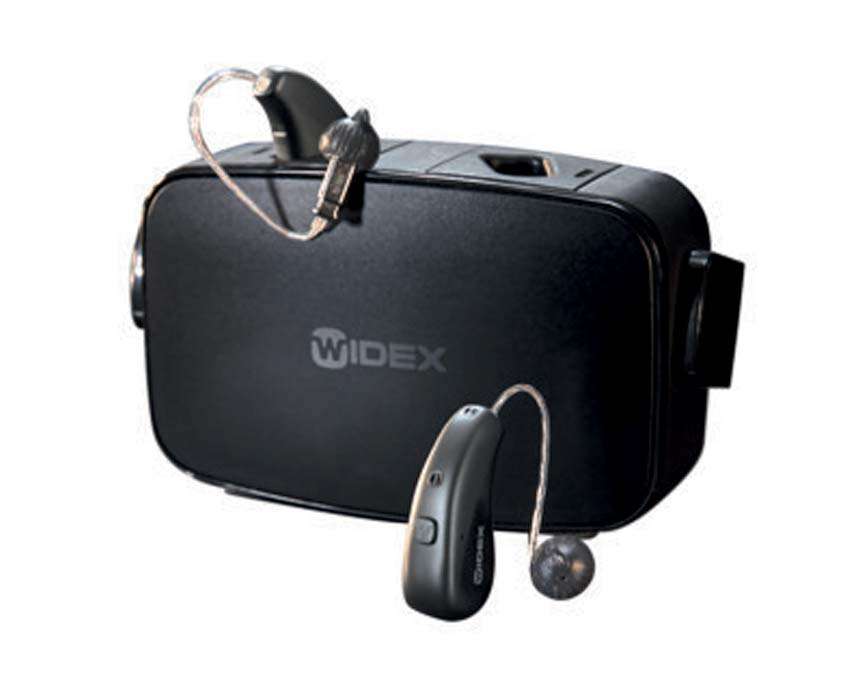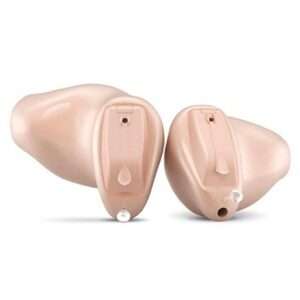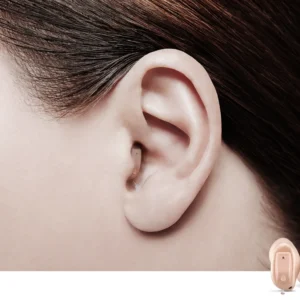What is a Widex Receiver-in-the-canal (RIC) hearing aid?
Widex Receiver-in-the-canal (RIC) hearing aids are a type of hearing aid that sits discreetly behind the ear and delivers sound via a small speaker or receiver that sits inside the ear canal.
RIC hearing aids are designed to be comfortable and unobtrusive, as the bulk of the hearing aid sits behind the ear, while the receiver that delivers the sound is small and sits inside the ear canal. This type of hearing aid can be customized to fit the individual’s ear canal size and shape, which can provide better sound quality and improved comfort.
Widex is a manufacturer of hearing aids, and their RIC hearing aids come in a variety of styles and models, each with different features and technology to meet the unique needs of the wearer. Some of the features of Widex RIC hearing aids include noise reduction, speech enhancement, wireless connectivity, and rechargeable batteries.
RIC hearing aids can be a good choice for people with mild to moderate hearing loss, as they provide amplification without being too noticeable or uncomfortable. However, they may not be suitable for those with severe or profound hearing loss. It’s always best to consult with a hearing healthcare professional to determine the best type of hearing aid for your individual needs.
How do I know if a Widex RIC hearing aid is right for me?
If you are experiencing hearing loss, the first step is to schedule an appointment with a hearing healthcare professional, such as an audiologist or hearing aid dispenser. They will conduct a comprehensive hearing evaluation to determine the extent and type of your hearing loss and recommend appropriate treatment options, which may include hearing aids.
During the evaluation, you can discuss your lifestyle, communication needs, and preferences with the hearing healthcare professional. Based on this information and the results of the hearing test, the professional may recommend a Widex RIC hearing aid or another type of hearing aid that best fits your needs.
Widex RIC hearing aids are typically recommended for people with mild to moderate hearing loss, as they provide discreet amplification and customizable fit. However, other factors such as the shape of your ear canal and personal preferences can also influence the choice of hearing aid.
It’s important to remember that hearing aids are highly individualized, and what works for one person may not work for another. Working closely with a hearing healthcare professional can help ensure that you find the best hearing aid for your unique needs and lifestyle.
What are the benefits of using a Widex RIC hearing aid?
There are several benefits to using a Widex Receiver-in-the-canal (RIC) hearing aid:
- Comfort: RIC hearing aids are designed to be comfortable and unobtrusive. The bulk of the hearing aid sits behind the ear, while the receiver that delivers the sound is small and sits inside the ear canal. This design can make the hearing aid more comfortable to wear, as there is less material in the ear canal.
- Sound quality: The receiver of the RIC hearing aid sits directly in the ear canal, which can provide more natural sound quality compared to hearing aids with a speaker in the ear mold or shell.
- Customization: RIC hearing aids can be customized to fit the individual’s ear canal size and shape, which can provide better sound quality and improved comfort.
- Discretion: RIC hearing aids are typically more discreet than other types of hearing aids, as the bulk of the device sits behind the ear, making them less noticeable.
- Wireless connectivity: Many Widex RIC hearing aids come with wireless connectivity features, allowing users to stream audio directly from their smartphones, televisions, and other compatible devices.
- Rechargeable batteries: Many Widex RIC hearing aids come with rechargeable batteries, which can provide convenience and save money on disposable batteries over time.
Overall, the benefits of using a Widex RIC hearing aid can include improved comfort, sound quality, and discretion, as well as the latest technology and features to enhance communication and enjoyment of daily activities.
Can a Widex RIC hearing aid help with tinnitus?
Yes, a Widex RIC hearing aid can help with tinnitus. Tinnitus is a common condition where individuals hear ringing, buzzing, or other noises in their ears, even when there is no external sound present. Widex has developed a specialized tinnitus management program called Zen Therapy, which is available in many of their RIC hearing aids.
Zen Therapy works by playing a personalized, soothing sound in the background to help mask the tinnitus noise. The sound can be customized to each individual’s preferences and needs, and it can be adjusted to be louder or softer depending on the severity of the tinnitus.
In addition, the Zen Therapy program includes relaxation exercises and mindfulness techniques to help individuals manage their tinnitus and reduce their overall stress levels. This holistic approach to tinnitus management can be very effective for many people, and the use of a Widex RIC hearing aid with Zen Therapy can help provide relief and improve quality of life.
It’s important to note that tinnitus management is highly individualized, and not all individuals with tinnitus will find relief with Zen Therapy or a Widex RIC hearing aid. However, many individuals have found success with these options, and it’s worth discussing with a hearing healthcare professional to determine if they are right for you.
How long does the battery last in a Widex RIC hearing aid?
The battery life of a Widex Receiver-in-the-canal (RIC) hearing aid can vary depending on the model, usage, and battery type. Widex offers both disposable and rechargeable battery options for their RIC hearing aids.
Disposable batteries typically last between 3 and 14 days, depending on the battery size and usage. The larger the battery, the longer it will last. It’s important to note that battery life can also depend on the environment, as extreme temperatures and humidity can affect the battery performance.
Rechargeable batteries, on the other hand, can last up to 20 hours on a single charge, depending on the hearing aid model and usage. Many of Widex’s RIC hearing aids feature a lithium-ion rechargeable battery, which can provide convenience and save money on disposable batteries over time.
It’s important to check the battery life and charging instructions for your specific Widex RIC hearing aid model, as the battery life and charging time can vary depending on the device.
Can I connect a Widex RIC hearing aid to my smartphone or other devices?
Yes, many Widex Receiver-in-the-canal (RIC) hearing aids can be connected to smartphones and other devices using Bluetooth technology. Widex offers a range of wireless connectivity options for their hearing aids, including:
- Widex SoundLink: This technology allows you to connect your hearing aids directly to your smartphone, TV, or other compatible devices, allowing you to stream audio directly to your hearing aids.
- Widex Remote Care: This technology allows you to connect with your hearing care professional remotely, so you can receive support and adjustments to your hearing aids from the comfort of your own home.
- Widex TV Play: This device streams high-quality audio directly from your TV to your hearing aids, providing a better listening experience for TV shows and movies.
- Widex Phone-DEX: This device allows you to connect your hearing aids to your phone, so you can make and receive phone calls directly through your hearing aids.
Overall, the wireless connectivity options available with Widex RIC hearing aids can enhance the user’s listening experience and provide greater flexibility and convenience in daily life.
How often do I need to replace the receiver in my Widex RIC hearing aid?
The receiver in a Widex Receiver-in-the-canal (RIC) hearing aid typically lasts between 6 and 18 months, depending on usage and environmental factors. The receiver is the part of the hearing aid that delivers sound directly into the ear canal, and it can be subject to wear and tear over time.
Factors that can affect the lifespan of the receiver include:
- Daily use: The more you use your hearing aids, the more wear and tear the receiver will experience.
- Moisture: Exposure to moisture, such as sweat or humidity, can cause the receiver to deteriorate more quickly.
- Earwax: Earwax can build up on the receiver and cause it to malfunction or reduce sound quality.
- Cleaning: Proper cleaning and maintenance of the hearing aid can help prolong the lifespan of the receiver.
If you notice a decrease in sound quality or other issues with your Widex RIC hearing aid, it’s important to have it checked by a hearing care professional. They can assess the condition of the receiver and determine if it needs to be replaced. Regular check-ups with a hearing care professional can help ensure that your hearing aids are working properly and can help prevent issues with the receiver or other components.
Can a Widex RIC hearing aid be adjusted to my specific hearing needs?
Yes, a Widex Receiver-in-the-canal (RIC) hearing aid can be adjusted to your specific hearing needs. When you first receive your hearing aids, they will be programmed by a hearing care professional based on the results of your hearing test and your individual preferences. This initial fitting is called a “real-ear measurement,” and it ensures that your hearing aids are programmed to provide the appropriate level of amplification for your hearing loss.
In addition to the initial fitting, your hearing care professional can make further adjustments to your Widex RIC hearing aid based on your feedback and needs. These adjustments can include:
- Volume control: Adjusting the volume level of the hearing aid to make sounds louder or softer as needed.
- Frequency adjustments: Adjusting the amplification at specific frequencies to improve speech understanding or reduce background noise.
- Directional microphone settings: Adjusting the hearing aid’s microphone settings to focus on sounds in front of you or all around you.
- Tinnitus management settings: Customizing the hearing aid’s tinnitus management program to better mask the tinnitus noise.
Your hearing care professional can also provide ongoing support and adjustments as your hearing needs change over time. Regular check-ups and adjustments can help ensure that your Widex RIC hearing aids are providing the best possible hearing experience.
How do I clean and maintain my Widex RIC hearing aid?
Proper cleaning and maintenance of your Widex Receiver-in-the-canal (RIC) hearing aid can help ensure optimal performance and extend the lifespan of the device. Here are some general tips for cleaning and maintaining your hearing aids:
- Clean your hearing aids regularly: Wipe your hearing aids down daily with a soft, dry cloth to remove any dirt, earwax, or moisture. Use a special cleaning tool or brush to remove any earwax or debris from the receiver, microphone, and sound outlet. Avoid using water or cleaning solutions, as they can damage the hearing aid.
- Store your hearing aids properly: When you’re not wearing your hearing aids, store them in a dry, cool place, such as a hearing aid case. Avoid exposing them to extreme temperatures or moisture.
- Replace the batteries regularly: If you have disposable batteries, replace them regularly to prevent the batteries from leaking and damaging the hearing aid.
- Schedule regular check-ups with your hearing care professional: Regular check-ups with your hearing care professional can help ensure that your hearing aids are working properly and make any necessary adjustments to the settings.
- Consider a professional cleaning: Your hearing care professional can also perform a more thorough cleaning and maintenance of your hearing aids. They can remove any earwax or debris that may be clogging the receiver or microphone and perform a diagnostic check of the device.
Overall, proper cleaning and maintenance of your Widex RIC hearing aid can help ensure optimal performance and extend the lifespan of the device.




